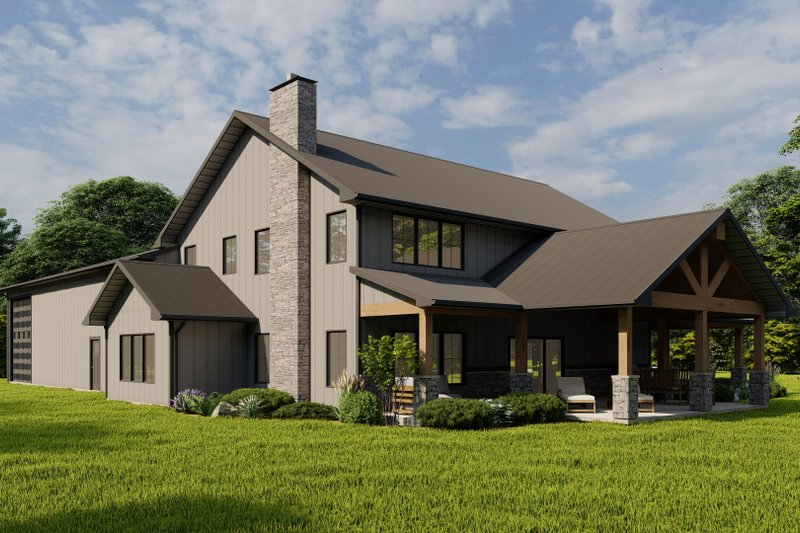Walkout Basement House Plans to Maximize a Sloping Lot

Building a home on a sloping lot offers unique challenges but also extraordinary opportunities.
One of the most innovative ways to take advantage of such terrain is by incorporating a walkout basement into your home design.
A walkout basement utilizes the natural incline of the lot to provide direct access to the outdoors, making the lower level an integral part of the home’s living space.
Whether you’re building in a hilly area with sweeping views or a forested lot with varying elevations, a walkout basement can transform your basement from a simple storage area into a bright, functional space that enhances the overall home.
What is a Walkout Basement?
A walkout basement is a lower-level space in a home with one or more walls above ground level, often with large windows or doors that lead directly to the outdoors.
This design allows the basement to have natural light and ventilation, making it much more livable than traditional subterranean basements, which tend to be dark and enclosed.
Unlike standard basements that are fully or mostly underground, walkout basements are built into the slope of the lot.
This positioning allows for more natural integration with the surrounding environment, as the lower level may have access to the yard or even a patio or deck, depending on the design.
Benefits of Building on a Sloping Lot
Maximizing Views
A sloping lot often offers panoramic views that can be fully utilized with a walkout basement.
Homes built on these lots can enjoy vistas of mountains, lakes, or cityscapes, and the walkout basement can be positioned to give the lower level occupants an uninterrupted view of the surroundings.
Large windows or glass doors are typically part of the design to create an open, airy atmosphere.
Natural Light
One of the biggest benefits of a walkout basement is the amount of natural light it can bring to the lower level.
Unlike traditional basements, which are often dark and require artificial lighting, the walkout basement, with its above-ground walls, can be equipped with large windows or glass doors that invite sunlight in, making it a much brighter and more pleasant space to live in.
Multi-Level Design
Sloping lots are ideal for homes with multi-level designs, which can optimize the natural flow of the land.
A walkout basement allows for a smooth transition between the lower and upper levels, creating a more cohesive living space.
This design offers better separation between public and private areas of the home, with the basement potentially serving as a separate living area, home office, or entertainment space.
Design Considerations for Walkout Basements
Site Evaluation
Before you begin designing your walkout basement, it’s essential to conduct a thorough site evaluation.
A professional will assess the slope, soil stability, and drainage patterns of the lot.
This evaluation ensures that your foundation is solid and that water flow is properly managed to avoid potential flooding or erosion issues.
Grading and Drainage
Proper grading and drainage are crucial when building a home with a walkout basement.
The lot must be graded to direct water away from the foundation, and drainage systems must be put in place to prevent water from pooling around the basement.
This might include installing French drains, retaining walls, or sump pumps, all of which will help maintain the structural integrity of your home.
Floor Plan Optimization
When designing the floor plan of a walkout basement, it’s important to consider how to maximize the space.
Open floor plans work well in walkout basements, as they allow for easy movement between the indoor and outdoor areas.
Integrating the lower level into the rest of the home’s living space can also make it feel less like a basement and more like an extension of the home.
In many cases, walkout basements are designed with seamless transitions into living rooms, dining areas, or even bedrooms.
How Walkout Basements Enhance Living Space
Additional Living Areas
A walkout basement can significantly increase the usable square footage of a home.
Many homeowners choose to transform their basement into functional rooms, such as a family room, guest bedroom, home office, or entertainment area.
The walkout design makes these spaces feel like an integral part of the home, rather than a dark, isolated lower level.
Outdoor Integration
With direct access to the outdoors, walkout basements provide an ideal connection between the home and the landscape.
You can create a patio, deck, or outdoor living area just outside the basement door.
This makes the basement perfect for hosting outdoor events or simply enjoying the natural surroundings.
Potential for Rental Income or Guest Suites
Another benefit of walkout basements is the potential to create a separate, self-contained unit.
The extra space can be used as a guest suite or even a rental apartment, providing you with an additional income stream.
Many walkout basements are designed with separate entrances, full bathrooms, and kitchenettes, making them ideal for long-term guests or tenants.
Walkout Basement Design Styles
Modern and Minimalist
Modern walkout basement designs focus on sleek, clean lines and the use of materials such as glass, steel, and concrete.
The emphasis is often on maximizing natural light and integrating indoor and outdoor living spaces.
Large glass doors and windows are a common feature, opening onto patios, gardens, or decks.
Traditional and Rustic
For those who prefer a more traditional look, rustic walkout basement designs incorporate natural materials like wood, stone, and brick.
These homes often blend seamlessly with the landscape, using earthy tones and organic materials to create a warm, inviting atmosphere.
Contemporary and Luxury
High-end walkout basements often feature luxurious finishes and cutting-edge technology.
In these designs, you might find features such as home theaters, wine cellars, or personal gyms.
The use of custom-built furniture and high-end materials can transform the basement into a truly luxurious living space.
Challenges of Building Walkout Basements
Soil Conditions and Stability
One of the biggest challenges when building on a sloping lot is ensuring that the soil is stable enough to support the foundation.
If the slope is too steep or the soil is too loose, additional work may be required to stabilize the foundation, which can increase construction costs.
Construction Costs
Building on a sloped lot, especially with a walkout basement, can be more expensive than building on a flat lot.
Excavation, grading, and specialized foundation work all contribute to higher costs.
However, the investment can be worth it, as a well-designed walkout basement can significantly increase the value of the property.
Zoning and Regulations
Local zoning laws and building codes can sometimes restrict the design and construction of walkout basements.
For example, there may be limits on how close to the property line the structure can be built, or there may be regulations about the height of the foundation.
It’s important to work with a builder who understands the local codes and can ensure compliance.
Tips for Successful Walkout Basement House Plans
Choose the Right Architect and Builder
Working with an architect and builder experienced in designing and building on sloping lots is essential.
They will help you navigate the challenges of sloped terrain and ensure that the design is both functional and beautiful.
Incorporate Sustainable Design
Sustainable design practices can be especially beneficial when building on a sloping lot.
Incorporating passive heating and cooling, energy-efficient windows, and eco-friendly materials can help you minimize the environmental impact of your home while keeping energy costs low.
Maximize Space
Be sure to make the most of the available space in your walkout basement.
With creative design, you can add functional areas like storage rooms, home offices, or even a gym.
This will ensure that the basement becomes an integral part of your home.
Landscape Thoughtfully
Landscaping plays a significant role in walkout basement designs.
Consider how the outdoor space can be integrated into the overall design, perhaps with outdoor dining areas, fire pits, or a garden that can be accessed from the basement.
Conclusion
Walkout basements are a brilliant way to maximize the potential of a sloping lot.
They not only enhance the functionality and livability of the space but also provide opportunities for creative design that incorporates natural light, outdoor living, and multi-level layouts. With careful planning and expert construction, a walkout basement can transform a sloping lot into a beautiful and practical home.
Whether you’re creating a family home or adding a rental unit, a walkout basement adds value, versatility, and a unique connection to the surrounding environment.
FAQ
What is the best slope for a walkout basement?
A moderate slope (around 5 to 15 degrees) is ideal for a walkout basement, as it allows for natural light, good drainage, and accessibility without the need for excessive grading or retaining walls.
Which type of house might be best suited for a sloping lot?
Houses with multi-level designs, such as split-level homes, contemporary modern homes, and those with walkout basements, are well-suited for sloping lots.
These designs make efficient use of the terrain and offer better integration with the landscape.
What are the disadvantages of a walkout basement?
Some potential drawbacks of walkout basements include higher construction costs due to grading, foundation work, and drainage systems.
Additionally, local zoning regulations may limit design options, and the slope could present challenges for certain terrains.
What elevation change is needed for a walkout basement?
Generally, a walkout basement requires a minimum elevation change of around 3 to 5 feet to ensure proper functionality.
This elevation allows for adequate natural light, ventilation, and access to the outdoors.
How much value does a walkout basement add?
A well-designed walkout basement can increase the value of a home by 10% to 15%, depending on factors like location, design, and market demand.
Homes with walkout basements tend to appeal to buyers due to the additional living space and functionality.
Are walkout basements desirable?
Yes, walkout basements are highly desirable as they offer bright, airy, and functional living spaces.
They also provide easy access to outdoor areas, making them ideal for recreation, guest rooms, or rental units.




